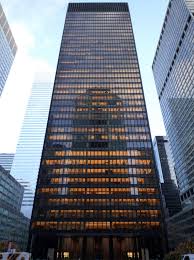Mies van der Rohe (Architect)
Ludwig Mies van der Rohe was a German architect, born in 1886 and active from 1920's to the 1960's. He died in 1969.
He created buildings and skyscrapers for Berlin (where there is a continental climate) that became the modernist style and have been called, by William McDonough (an American architect), when transferred to America 'vertical gas chambers' because of their lack of opening windows for ventilation, and their all-glass facade which would overheat on most days, especially in the summer causing discomfort and thermal stress for their occupants.
He had a number of well-known sayings which have been frequently misinterpreted as "less is more", so all you get is a roof, floor, and glass walls around the outside. The more is the aesthetic or emotional response with many people appreciating this look. He said "God lies in the details" to mean that you must work to get the details right (to give the best look or aesthetic emotional response), and in so doing seeking and finding God.
He spent a lot of time designing the Barcelona chair that is used in many waiting rooms and movies, even to the extent of going back in his 60's and trying to improve it, saying it was the hardest thing he had designed in his life. The author assumes this is because we use a chair differently to how we use buildings, and at different times need much more of a chair and others much less.
His notable buildings include:
- Seagram building (shown below, a skyscraper, that many others copied)
- Farnsworth house, for Dr Farnsworth, who insisted on walls between the bedroom and kitchen.
He moved to Chicago in the late-1930s and drew upon the International Style for some of his most celebrated modernist works. The AMA Plaza (formerly the IBM Plaza), was his last building and exemplifies his trademark minimalist aesthetic.
[edit] Related articles on Designing Buildings Wiki
Featured articles and news
Latest Build UK Building Safety Regime explainer published
Key elements in one short, now updated document.
UKGBC launch the UK Climate Resilience Roadmap
First guidance of its kind on direct climate impacts for the built environment and how it can adapt.
CLC Health, Safety and Wellbeing Strategy 2025
Launched by the Minister for Industry to look at fatalities on site, improving mental health and other issues.
One of the most impressive Victorian architects. Book review.
Common Assessment Standard now with building safety
New CAS update now includes mandatory building safety questions.
RTPI leader to become new CIOB Chief Executive Officer
Dr Victoria Hills MRTPI, FICE to take over after Caroline Gumble’s departure.
Social and affordable housing, a long term plan for delivery
The “Delivering a Decade of Renewal for Social and Affordable Housing” strategy sets out future path.
A change to adoptive architecture
Effects of global weather warming on architectural detailing, material choice and human interaction.
The proposed publicly owned and backed subsidiary of Homes England, to facilitate new homes.
How big is the problem and what can we do to mitigate the effects?
Overheating guidance and tools for building designers
A number of cool guides to help with the heat.
The UK's Modern Industrial Strategy: A 10 year plan
Previous consultation criticism, current key elements and general support with some persisting reservations.
Building Safety Regulator reforms
New roles, new staff and a new fast track service pave the way for a single construction regulator.
Architectural Technologist CPDs and Communications
CIAT CPD… and how you can do it!
Cooling centres and cool spaces
Managing extreme heat in cities by directing the public to places for heat stress relief and water sources.
Winter gardens: A brief history and warm variations
Extending the season with glass in different forms and terms.
Restoring Great Yarmouth's Winter Gardens
Transforming one of the least sustainable constructions imaginable.























